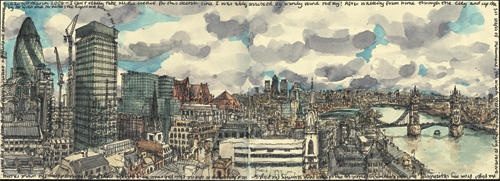A recent report published by the Civil Aviation Authority (CAA) examines the impact that no-frills airlines have had on the airline market, on passengers and on society more widely. The report called “’No-frills carriers: Revolution or Evolution?’ shows that no-frills airlines have revolutionised the short-haul airline market, radically changing the fares on offer, and the choice of airlines, airports and destinations available to passengers. Other airlines now run their businesses differently as a result of the advent of no-frills airlines,” stated CAA. “However, contrary to common perceptions, no-frills airlines appear to have had little impact on overall rates of traffic growth, and there is little evidence of any marked change to the income and socio-economic profile of air passengers.” Most of the no-frills airlines’ growth seems to have been at the expense of other carriers. Although the number of leisure passengers from all income groups has increased, the majority of this increase has come from those in middle and higher income and socio-economic groups.
All posts by The Beetle
MSN Travel Channel
MSN.co.uk has re-launched its travel channel which has teamed with major travel brands including Expedia and Conde Nast Traveller, comprises “exclusive content, bespoke information and a holiday booking service provided by Expedia”. There are travel guides from Rough Guides and Dorling Kindersley in addition to independent travel opinions by Tripadvisor. Guardian Travel will provide travel features and its archive will also be available. The channel is aimed at 25- to 44-year-old frequent flyers, who travel regularly and book their holidays online.
MEETING NEWS
Meeting News from London by Padmassana November 2006 London Meeting
Our first speaker was Janice Booth, whose talk on Rwanda was something different. Instead of highlighting the gorillas and monkeys that tourists go to see Janice told us about how she became involved with the country. She began by doing translation work, which then lead to sponsoring a child through Primary school. Janice had kept a distance between the country and herself, but after the genocide she wanted to find out if Peter, the child she had sponsored, had survived. She went ot Kigali not knowing what to expect, but delighted at the peoples integrity, such as the newpaper seller, who went running off with a large denomination note, to return quite a while later beaming with Janice’s change. Janice got in touch with an ex headmaster from one of the schools who told her to come back in a week after he had made enquiries. Janice used the week to explore the country and returned to the news that Peter had been killed, however a brother had survived and one of his sisters, Chantalle, was living in Kigali. Janice got in touch with Chantalle and was able to discover Peter’s fate.Janice has since been able to help Chantalle. Janice is still deeply involved with Rwanda, having lead tours there when the tourist industry was re-emerging and helping with charity projects as well as being the author of the Bradt guide to Rwanda. Globies had a collection on the day raising over £60.
Our second speaker was the ever popular Martin Featherstone! Martin is a Globie and has spoken on a number of occassions. This afternoon’s talk on Morocco was as entertaining and irreverant as ever. Ex soldier Martin started by saying he thought Janice very brave as he wouldn’t go to Kigali without 60 paratroopers behind him! Martin drove through France and Spain and got the ferry across to Tangier. Big mistake he said, as it took him four hours to get through the arabic entry red tape. Once he had escaped he headed out into the desert, visiting Foreign Legion forts. Trying to navigate by GPS and incomprehensible arabic road signs. One Belgian Cafe owner, whose establishment is way out in the desert does not have an address, he advertises in off road magazines just with his gps co-ordinates, Martin’s gps found it ok! The GPS’s map showed bold lines denoting roads, but these turned out to be nothing more than boulder strewn tracks in the desert. Martin also travelled along the coast, which is littered with the rusting hulks of ships wrecked along alongthe beaches. To his surprise the 21st century has reached places like Tantan where Martin was able to visit a cyber cafe and send home that days photo’s to those at home. The locals fascinated watched over his shoulder until he opened an e-mail with a pornographic attachment! Martin’s trip took him to the Algerian border and a run in with the Moroccan military, before heading back to the relative safety of Marakech, where he showed us the goings on in Djem-el-fna, including a picture of a uk school teacher on holiday. (you had to be in the room to get this one!)
By Padmassana
Coming Next:
Saturday, 2nd December
Helena Drysdale will be talking about Strangerland – Travels in the Footsteps of a family at war in 19th century New Zealand Helena discovers her pioneering 19c cousins who leave the East India Co. for backbush NZ. Tales of war, adultery and God – photos paintings / views from Himalayas to the Chatham Islands and John Pilkington will be showing slides on The Heart of the Sahara; in early 2006 John joined a camel caravan from Timbuktu to the notorious salt mines of Taoudenni – a three week/450-mile journey to the very heart of the Sahara. Stunning desert landscapes and a taste of Sahara life as it was a millennium ago, when the Taoudenni mines were first established and salt was worth its weight in gold.
London meetings are held at The Church of Scotland, Crown Court, behind the Fortune Theatre in Covent Garden at 2.30pm the first Saturday of each month. There is no London meeting in August, but we will be back in September. For more information, you can contact the Globetrotters Info line on +44 (0) 20 8674 6229, or visit the website: www.globetrotters.co.uk
Meeting News from Ontario
For information on Ontario meetings, please contact Svatka Hermanek: shermane@schulich.yorku.ca or Bruce Weber: tel. 416-203-0911 or Paul Webb: tel. 416-694-8259.
Meetings are held on the third Friday of January, March, May, September and November, usually at the Old York Tower, 85 Esplanade (It is at the south-east corner of Church & Esplanade – 2 blocks east from the Hummingbird Centre at 8.00 p.m. Meetings are held on the third Friday of January, March, May, September and November. Usually at the Woodsworth Co-op, Penthouse, 133, Wilton Street in downtown Toronto at 8.00 p.m.
Cruising The Bosphorus
There are so many things to see and do in Istanbul, it is the most enchanting city. One of the best trips that the Beetle made was a trip up the Bosphorus. The Bosphorus is a strait of water separating the European and the Asian parts of Istanbul. It is 35 km (20 miles) long and connects the Marmara Sea at the south to the Black Sea in the north.
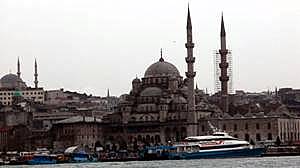 A bit of history about the name: the English name comes from a Greek legend concerning Zeus who had an affair with a beautiful women called Io. When Hera, Zeus’ wife discovered his infidelity, she turned Io into a cow and created a cloud of flies to sting her on the backside. Io jumped across the strait and the name Bosphorus is said to mean the ‘crossing-place of the cow.’
A bit of history about the name: the English name comes from a Greek legend concerning Zeus who had an affair with a beautiful women called Io. When Hera, Zeus’ wife discovered his infidelity, she turned Io into a cow and created a cloud of flies to sting her on the backside. Io jumped across the strait and the name Bosphorus is said to mean the ‘crossing-place of the cow.’
There are many interesting places you can see from the Bosphorus, including the Topkapi Palace and the Camii Yeni, the New Mosque of the Sultan’s mother, which was begun in 1615, on the model of the Ahmet I Mosque, for Ahmet’s mother but completed only in 1663. – see picture above.
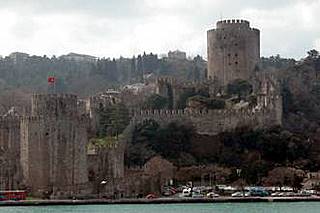 As you leave the main part of Istanbul and travel up the Bosphorus towards the Black Sea, one of the first things you see is the Rumeli Hisari fortress built under the orders of the Conqueror Mehmet in 1452 to control commercial and military traffic in preparation for the siege of siege of Constantinople. Some guides say that the fortress was used as a rather impressive Bosphorus toll booth, then as a barracks, later as a prison, and finally as an open-air theatre, but never again as a fortress.
As you leave the main part of Istanbul and travel up the Bosphorus towards the Black Sea, one of the first things you see is the Rumeli Hisari fortress built under the orders of the Conqueror Mehmet in 1452 to control commercial and military traffic in preparation for the siege of siege of Constantinople. Some guides say that the fortress was used as a rather impressive Bosphorus toll booth, then as a barracks, later as a prison, and finally as an open-air theatre, but never again as a fortress.
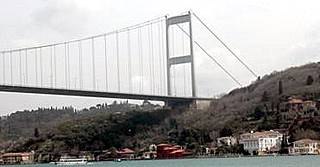 Continuing to travel up the Bosphorus, you pass under the Fatih Sultan Mehmet Bridge. This bridge is named after the Turkish conquer of Constantinople (Fatih means “conqueror”) in 1453. It spans the Bosphorus at its narrowest point—where it is only 0.5 mi. [0.66 km.] wide.
Continuing to travel up the Bosphorus, you pass under the Fatih Sultan Mehmet Bridge. This bridge is named after the Turkish conquer of Constantinople (Fatih means “conqueror”) in 1453. It spans the Bosphorus at its narrowest point—where it is only 0.5 mi. [0.66 km.] wide.
Continuing up the Bosphorus you can see the Beylerbeyi, a summer palace built in the 1860s. 
Throughout the entire trip you can see beautiful old wooden houses, called Yalis, palaces, mosques and a couple of forts. Then there is a mixture of stately homes and summer houses and fishing villages. Below is a selection of photos showing some of the scenery along the banks of the Bosphorus.
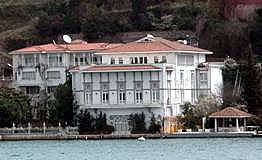


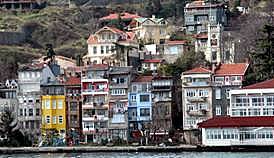
The end of the trip up the Bosphorus culminates at Rumeli Kavagi and Anadolu Kavagi about 10 km (6 miles) south of the Black Sea, though you can see the Black Sea in the distance. If you take the traditional ferry’s Bosphorus tour to Anadolu Kavagi, you have three hours to walk, explore, have lunch until the ferry’s departure for the return to Istanbul.
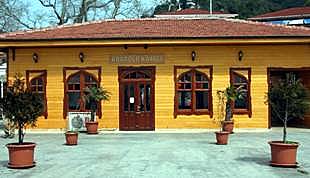


As an alternative, it is possible to get off the boat in Sariyer, have lunch, then take a bus, coach or taxi south along the shore back to Istanbul. A timetable of ferries can be found here. The Beetle took a few hours to have a very tasty lunch and explore the ruins of the fortress on Anadolu Kavagi which date back to 1350 and was originally built by the Genoese. The pictures above show some scenes from Anadolu Kavagi and its fortress.
Trans-Atlantic the Hard Way– 60 Days of Rowing by Lew Toulmin
Fancy a romantic trans-Atlantic cruise with your sweetheart? How about a nice, relaxing voyage where you row 16 hours a day for 60 days, eat lukewarm freeze-dried food, roll your vessel upside down four times, and fend off the amorous advances of a 60-foot whale? Meet Liz O’Keeffe and Richard Mayon-White, two British adventurers (see photo below) who have done all that and much, much more. I interviewed them at Nelson’s Dockyard in Antigua, West Indies. 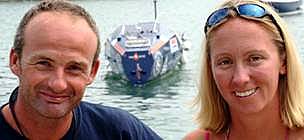
Q: Tell me about the voyage.
Richard: Just a few days ago, on January 30, 2006, we completed our 2900-mile row across the Atlantic, as part of the Atlantic Rowing Race. We are the first mixed pair team to finish here in Antigua. This type of racing began in 1995 and is now very popular.
Liz: The Race included 26 teams who set off on the 30th of November 2005 from Gomera in the Canary Islands. Most teams were pairs, but there were four vessels with four persons aboard, and two solo rowers. Our team is named Row4Cancer and we have raised over 40,000 [$75,000] for cancer relief. We often use the boat to carry cancer sufferers, especially kids, for short races to take their minds off their troubles. They love it.
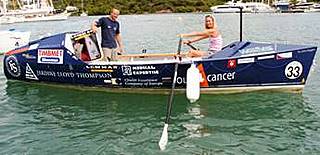 Q: Tell me about your boat.
Q: Tell me about your boat.
Liz: Our boat is named Bilbo Baggins, after the Hobbit character and after our wonderful black Labrador who sadly had to be put down, and is buried near where we kept the boat.
Richard: The race requires all boats to be of a standard size – 24 feet long with a nine millimetre [about inch] thick plywood hull. There is no real competition regarding external boat design. But each team can design their vessel’s interior. We bought a used boat, gutted it, and rebuilt every single system – electrical, navigation, steering, rowing, communications, water-making, cooking, etc. It took three years and required a budget of 60,000 [$113,000].
Q: How old are you, where are you from, and what is your profession?
Liz: I am 29, from Poole in the UK but born in Holland, and I work in insurance sales.
Richard: I am 39, from Oxford, and am a consultant in leadership and personal development. We live in Southampton now.
Q: How did you prepare for the race?
Richard: We both compete regularly in triathlons, Ironmans and marathons. We both have our Royal Yachting Association Yachtmaster Offshore and other RYA qualifications, and have both taught sailing. I climbed Kilimanjaro and Mt. Aconcagua (the highest mountain in South America) and other peaks. I sailed in the famous Fastnet yacht race, and we did lots of weight training, rowing in the gym, and rowing the boat when it was ready.
Liz: I competed at the national level in sailing, netball, trampoline, tennis, triathlons and rugby. Before the start we both bulked up, which was a good thing, since we both lost over 24 pounds during the race. While racing we ate mostly freeze-dried food, which we boiled in the bag.
Richard: We figure that two-thirds of this kind of race is in the preparation, and if you get to the start line, the chances are good that you will finish.
Q: Tell me about your whales.
Richard: We saw lots of whales and dolphins. One calm day a 60 foot sei [baleen] whale came up on us. He dwarfed our little 24-foot boat. For 45 minutes he circled our boat, eyeing us.
Liz: He seemed to be kind of lonely. Our boat has grey antifouling paint underneath and our oars look kind of like flippers, so after a while we realized that he thought we were an odd but attractive female!
Richard: Yes, he had a little twinkle in his eye, and seemed keen for some joy in life. At one point he got underneath the boat and looked up at us, rather plaintively.
Liz: We tried to gently row away, to give him the message that we weren’t interested. But as soon as we started moving he dashed after us. Finally he gave up and we crept away.
Richard: Another time we were in a storm surfing some big waves, and we saw a big whale surfing down after us. But we got away from him, too. We never saw any sharks, although two race boats were attacked by sharks.
Q: What sort of other problems did you have?
Richard: Everyone expected that the race would have fairly calm weather, like most years. And we hoped to break the mixed pair record of 53 days for the crossing. But the 2005/6 hurricane and storm season lasted so long that everyone had troubles. All the boats were affected by hurricane Epsilon, tropical storm Zeta, and by other smaller storms. We rolled over four times.
Liz: All the boats are self-righting if the vents and doors are closed. But it is so hot, humid and miserable inside the tiny 6-foot cabin when everything is buttoned up that it is very hard to keep it closed. About 400 miles from the finish we saw one of the two support vessels, which always seemed to bring us bad luck. Right then we surfed down a big wave and broke our rudder. We tried to fix it for a day, but rolled again.
Richard: Then we were rolled a third time. Liz was rowing and I was in the cabin.
Liz: A massive wave broke over the boat. I was wrenched out of the rowing seat and thrown overboard. I thought I had broken my leg. But I managed to swim back and get over the gunwale, which luckily was very low because the boat was swamped. I was in agony for about 24 hours, but rested up and kept going. My leg wasn’t broken, after all – it was only a torn muscle.
Richard: Our vent was open and so we got lots of water inside, and of course our gear was a mess. But we bailed her out, kept afloat, immobilized Liz’s leg, and managed to fix the rudder after five days of work. At that point we just focused on survival. We never thought we’d make it to Antigua.
Liz: Probably the worst part of the trip was hanging on the sea anchor for days, waiting for the storms to subside. Then the cabin is like being inside a washing machine, it’s so rough.
Q: What was your fastest speed?
Richard: We recorded an unbelievable speed of 18.6 knots surfing down some huge waves. The noise and vibration were incredible. Normally when rowing we average one or two knots over the ground [distance actually made good], and 70 percent of that is probably current. We are not allowed to hoist any sails, of course.
Q: After all this are you still keen on getting married?
Richard: Yes, we were engaged before the race and we are still engaged.
Liz: We know some pairs that went ashore after the race, walked off in opposite directions, and never spoke to each other again. But we want to keep having adventures together.
Q: What plans do you have?
Richard: We have a long list of projects. We think this kind of adventure helps define us as people. I want to sail around the world alone. I want to race in the 100-mile portion of the Tour de France that is open to the public, bike in the Race Across America, drive in the Plymouth to Dakar 100 car challenge, climb Mt. Denali [McKinley] in Alaska, sail in the Sydney—Hobart yacht race, and participate in the Iditarod sled dog race.
Liz: We are thinking of climbing Mt. Vinson in Antarctica for our honeymoon.
Richard: Yes, we want to have some stories to tell our children and grandchildren.
Toulmin: Somehow, I don’t think that will be a problem.
For more information, see www.row4cancer.com. The race organizers, Woodvale Events, are planning an Atlantic Race in 2007-8 and an Indian Ocean Rowing Race in 2009, if you want to get started on your preparation. See www.woodvale-events.com for details of these races and other individual adventure projects.
About the author: Lew Toulmin is the author of The Most Traveled Man on Earth, which describes the most travelled people, their travel tips and wisdom, and also his adventures in catching up — he has worked in 30 countries and visited 170 countries and sovereign territories. Lew’s book is available from www.amazon.com or www.amazon.co.uk, or direct from The Village Press, 13108 Hutchinson Way, Silver Spring, MD 20906 USA, at $16.95 plus shipping ($5 to the US or $14 overseas). He can be reached at LewToulmin@aol.com
About the photos:
1. Richard Mayon-White and Liz O’Keeffe in Antigua just after completing their 2900-mile row across the Atlantic. In the background between them is their vessel Bilbo Baggins.
2. Richard Mayon-White and Liz O’Keeffe of team Row4Cancer aboard their vessel Bilbo Baggins. Liz shows her rowing position just before being thrown overboard in one of the four rollovers the team suffered during the trans-Atlantic race.
Explore the Island Pleasures Tucked in the Caribbean by Clinton Douglas IV
The Cayman Islands, nestled in the temperate and scenic Caribbean, are a paradise retreat for celebrities and vacation travellers across the world. Three English- speaking islands, Grand Cayman and its sister islands, Little Cayman and Cayman Brac, are small communities just an hour south of Miami secluded in the pristine Caribbean Sea. Local weather is tropical, with warm and rainy summers and cool, dry winters. Whether you’re trying to beat the winter blues, seeking a romantic or honeymoon get-away, looking for the ideal trip for the entire family or just in need of some down-time from urban stress and job tension, the Cayman Islands offer warmth, laid- back comfort and utter serenity.
Discover an Underwater Paradise: the sister islands are best known for their diving and snorkelling, rated one of the leading five destinations in the world. The islands are home to some of the most magnificent fish-covered coral reefs and dramatic drop-offs imaginable, being a favoured spot for underwater photographers for years on end. Each island composes the flattened tip of Cayman Ridge, a sub-sea mountain range. This formation provides unique opportunities for both shallow and wall diving. Both small party diving excursions and submarine rides help you intimately explore Atlantis and its underwater wonders. Submarine rides plunge as low as 60 feet deep, while semi-submarines offer a full, 360-degree view through well-protected glass within air-conditioned comfort.
Onshore Recreation and Relaxation: the pristine waters and secluded locale leave your mind and body refreshed and invigorated. Island water sports offer plenty of entertainment, with year-round recreation ranging from paddle boats and cats to sun searcher floats, banana boat and sailboat rides. The Cayman Islands are also drenched with rich, exciting attractions. Its pleasant climate makes it the ultimate setting for bicycling, golf, running, cricket and horseback riding. Enjoy a day on the go, then pamper yourself in one of the island’s world-class spas.
Food: island Cuisine is influenced by its wondrous heritage, delighting your taste buds with Jamaican favourites like curry and jerk along with extraordinary seafood, lobster, fresh fruits, breadfruit, plantain and cassava. The main island has more than 150 restaurants serving native, American, German, Mexican, Italian and other delicacies, as well as fast-food and snack outlets with subs and hamburgers.
Night life: when the sun sets, the nightlife comes alive with dazzling Caribbean colour. The Islands are home to a range of events and hot spots, from the gritty jazz sessions, nightclubs, steel band concerts and Pirates Week festivals to sophisticated cultural events, local theatre and fine dining. For more information about hospitality and travel deals, visit http://www.vasrue.com.
Cascais, Portugal, as a Weekend Break
Cascais is a great weekend break from the UK. There are several airlines that fly to Lisbon, including EasyJet, Monarch, British Airways and Monarch. From Lisbon airport, it is a fifty minute bus journey on the Aerobus, costing just 8.50 euros to Estoril or Cascais.

Cascais is 6.5km (4 miles) W of Estoril and 61km (38 miles) west of Lisbon. From 1870 to 1908, the Royal Family came to Cascais for the sea air, turning the Portuguese quiet fishing village into an ‘it spot’. The citadel gained electric light in 1878, the first in the country, thanks to King Lus.  The village gained better roads to Lisbon and Sintra, a casino, a bullfight ring, a sport club and improvements in the basic infrastructure for the population. The railway arrived in 1889. Many aristocratic families built beautiful mansions in Cascais, many of which can still be seen in the centre and surroundings of the town. In the 1930s, Cascais’ popularity revived and attracted artists and writers to its little cottages. During WW2 several Kings and heads of European countries and their aristocratic entourages sought refuge in Cascais and nearby Estoril. Today Cascais is a dormitory town of Lisbon but there is still a lot to see and do.
The village gained better roads to Lisbon and Sintra, a casino, a bullfight ring, a sport club and improvements in the basic infrastructure for the population. The railway arrived in 1889. Many aristocratic families built beautiful mansions in Cascais, many of which can still be seen in the centre and surroundings of the town. In the 1930s, Cascais’ popularity revived and attracted artists and writers to its little cottages. During WW2 several Kings and heads of European countries and their aristocratic entourages sought refuge in Cascais and nearby Estoril. Today Cascais is a dormitory town of Lisbon but there is still a lot to see and do.
 Cascais is still a small, pretty fishing port which is small enough to be explored on foot over the course of a weekend. The town is dominated by a small beach with a still active fishing industry. There is a pretty harbour with lots of splendid yachts mixed with small fishing boats. Legend even has it that it was a Cascais fisherman, a certain Afonso Sanches, and not Columbus who discovered the New World ten years before the famed date of 1492.
Cascais is still a small, pretty fishing port which is small enough to be explored on foot over the course of a weekend. The town is dominated by a small beach with a still active fishing industry. There is a pretty harbour with lots of splendid yachts mixed with small fishing boats. Legend even has it that it was a Cascais fisherman, a certain Afonso Sanches, and not Columbus who discovered the New World ten years before the famed date of 1492.
Behind the harbour and the beach is an old town with a maze of small streets and side streets with shopping, an internet caf – don’t forget to explore the small side alleys, plenty of which feature tucked away little restaurants, often with fixed price menus with good food.
Also tucked away in the back streets is the fish market where some of the fisherman haul their small boats and catches. See photo below.

In 1926 the railway line from Lisbon to Cascais was the first to be electrified in Portugal and this is the best way by public transport to get in to Lisbon if you want to do some shopping. Cascais is at the end of the line and the train takes you along to coast to Cais do Sodre. From there, you can easily transfer to Lisbon’s metro which is frequent, safe and inexpensive and allows easy access to all the things and places you may want to do or visit in Lisbon. Though there is shopping to be had in and around Cascais in the form of trestle table markets where the speciality is fine linens and embroidery and there is one shopping complex in Cascais and another much larger one on the road to Sintra.
 There is the Museu do Mar that depicts the story of Cascais and its fishing history. Three kilometres, about a 20-minute walk along the coastal road outside town is the Boca do Inferno where on rougher days the sea hammers into the rock through a blow hole creating spectacular spray giving meaning to the English translation of “mouth of hell.” A small piece of trivia: Aleister Crowley came to Boca do Inferno to fake his own death in 1930. It is possible to walk all the way from Cascais to Estoril along a waterfront boardwalk where you can see plenty of beaches, though these can become crowded in the summer months.
There is the Museu do Mar that depicts the story of Cascais and its fishing history. Three kilometres, about a 20-minute walk along the coastal road outside town is the Boca do Inferno where on rougher days the sea hammers into the rock through a blow hole creating spectacular spray giving meaning to the English translation of “mouth of hell.” A small piece of trivia: Aleister Crowley came to Boca do Inferno to fake his own death in 1930. It is possible to walk all the way from Cascais to Estoril along a waterfront boardwalk where you can see plenty of beaches, though these can become crowded in the summer months.
The best beach nearby (reached by bus from outside the train station every one or two hours) is the sandy beach of Guincho – see photo right. If surfing is your thing, the beach at Guincho has high waves that attract windsurfers from around the globe and has hosted the World Surfing Championships. The next town to the east of Cascais is the resort town of Estoril dominated by the Casino – which was used as the basis of the James Bond film Casino Royale.
To the north and within easy reach is the lovely hill town of Sintra and which was described in glowing terms by Lord Byron. All in all, a good destination for a long weekend with a chance to stay in Lisbon and visit Cascais and Estoril or stay in Cascais and visit Lisbon and Estoril.
Getting in to Barcelona from the Airport – All you want to know Manuel Kupka
There is only one airport in Barcelona city, commonly known by the locals as L’Aeroport del Prat. Barcelona Airport is located 12 kilometres south-east of Barcelona city centre and 3km from Barcelona’s harbour (one of the most important in the Mediterranean Sea). There are a few ways you can get from Barcelona Airport to the city centre, let’s have a look at them so you can go by;
By Taxi is without doubt the fastest way to leave Barcelona Airport but not necessarily the fastest way to get to your destination. Barcelona, is a big modern city and has so much traffic that sometimes it can drive you nuts. The airport taxi rank is on the left hand side when you leave the airport main exit. There are taxis 24/7 all year long and they’ll always have change of a 20 euro note (this is your right as a customer) but any bigger note than that, could cause you problems when paying, especially late at night. All official Barcelona taxis are black and yellow and are required to charge you only the value on the meter, though the Beetle has heard stories of unscrupulous taxi drivers who won’t give change and drive off with a large note – but this is taxi drivers the world over. Expect to pay around 25 euros for the journey into the centre of town. There will also be an additional surcharge charge for each bag you’re carrying. The rates are displayed inside the cab. Taxi drivers have been obliged to accept guide dogs for blind people since 1993 by law.
By AeroBus. The AeroBus is, as you may have already guessed, a Bus service. It’s simply one of those Airports to City Centre destinations only that all big airports have. This service runs normally runs every 15 minutes within its fixed hours of operation (see official website) for the exact timetable for the Aerobus.) You can catch the Aerobus from the airport and it stops at all 3 terminals. The aerobus will then take you to the city centre where you can get off at either Placa Espana or Placa de Cataluna in the city centre. From there you can catch the metro – see here for a map and details of the barcelona metro. Please note that the metro does not run to the airport. You buy the ticket on the bus, it costs (at the time of writing) 3.75 euros one-way and 6.45 euros return, they accept Visa. The journey from Barcelona Airport to the city centre is about 30 minutes long.
By Night Bus. There is also a regular local night bus, the 106, which takes you from Barcelona airport to Plaza Espana. This is the only late night public transport service available. Try to be at the bus stop about 10 minutes early, as the timetables are approximate and it always depends on traffic. You can buy a ticket on board just try to have some change on you. If you don’t know where you have to get off, ask tell the driver which your stop is and he’ll let you know.
By Train. The RENFE train service runs approximately every 30 mins to and from Barcelona airport to the city centre. The travel time approximately 25 minuets. If travelling from the airport to the city centre you will need to get off at Barcelona Sants and change either for another RENFE train to Placa Catalunya or for the Barcelona metro underground system. If you have not bought a T10 ticket and just purchased a normal ticket then you will have to buy another ticket for the change at sants. If you have a T10 ticket you can change without paying an additional charge. The metro runs directly from Barcelona Sants station and from Passeig de Gracia. Barcelona Sants station is a major rail station that offers train connections to many other destinations outside Barcelona. The price depends on where you stop but getting to the centre will cost you 2.30 euros. You can get straight into four of Barcelona’s main train stations offering connections to anywhere in Spain. Be warned that you’ll need your ticket on arrival at your destination, so don’t throw your ticket away. While you can take your pets on local transport, they must be on a lead or in some sort of cage. You can also take bicycles on the local train but there are some restrictions at peak times.
By Car. There are many car hire companies based in Barcelona Airport. If you plan to drive in the city you’d better get hold of a good street map, remember Barcelona isn’t a small city (over 3 million people live there and most of them have cars.) The journey to the city could take about 20 minutes but that will depend on traffic conditions. If you plan to stay in Barcelona city, I wouldn’t recommend hiring a car as it’d be more trouble than it’s worth and public transport can take you anywhere at anytime. However if you plan to visit the outskirts of the city, a car would be helpful.
For more information on timetables and routes, see:
Globetrotter Karen Neale’sBook Launch
![logo[1]](https://globetrotters.co.uk/newsletter/wp-content/uploads/sites/2/2006/10/logo1.jpg) Karen (see photo left) is a London based artist and architect whose passion is sketching and painting life around her, in her annotated, watercolour sketchbook diaries.
Karen (see photo left) is a London based artist and architect whose passion is sketching and painting life around her, in her annotated, watercolour sketchbook diaries.
Karen says, “This might be in the bustle of a market, on the top of a cathedral or down in a wine cellar, the middle of a city or even the middle of nowhere. I have kept annotated, watercolour sketchbook diaries for almost twenty years. I stand in situ and draw with bic biros, (I do not use a camera) adding watercolour and notes around the perimeter. Sometimes the words venture into the drawing and become an integral part.”
Karen goes on to say, “In 2001 I was awarded a ![Corb-and-House-flat[1]](https://globetrotters.co.uk/newsletter/wp-content/uploads/sites/2/2006/10/Corb-and-House-flat1-233x300.gif) Winston Churchill Fellowship to undertake an artist’s journey through World Heritage Cities and Sites from France, travelling eastwards through eight countries, including Iran, Uzbekistan and India to Nepal, recording it all in the pages of my sketchbook diary. Subsequently I have spent time in Cuba, and the World Heritage City of Havana, culminating with a solo exhibition of my work at the British Ambassador’s Residence there.”
Winston Churchill Fellowship to undertake an artist’s journey through World Heritage Cities and Sites from France, travelling eastwards through eight countries, including Iran, Uzbekistan and India to Nepal, recording it all in the pages of my sketchbook diary. Subsequently I have spent time in Cuba, and the World Heritage City of Havana, culminating with a solo exhibition of my work at the British Ambassador’s Residence there.”
Karen’s work has included a community project along Hadrian’s Wall, and sketching in and around the Palace of Westminster, both of which are World Heritage Sites, as well as a spell as ‘artist in residence’ at the Athenaeum. Karen was also the ‘MCC Young Cricket Artist for 2005’, based at Lord’s Cricket Ground.
On October 9th 2006, Karen’s London sketchbook diary was published by Methuen, and launched (see photo right) together with an exhibition of paintings from the sketchbook at the Waterloo Gallery, London where various London glitterati and Globetrotters turned up to sup wine and admire Karen’s superb drawings.
If you would like more information about Karen’s work or would like to contact her, please visit her website or e-mail her on: info@karenneale.co.uk
London in Landscape can be purchased online from The Westminster Bookshop and Amazon Books as well as all good bookshops.
Santiniketan, West Bengal, India by Arjun Mukherjee
Santiniketan is a small town near Bolpur in the Birbhum district of West Bengal, India, and approximately 180 kilometres north of Kolkata (formerly Calcutta). It was made famous by Nobel Laureate Rabindranath Tagore, whose vision became what is now a university town (Visva-Bharati University ) that attracts thousands of visitors each year. Santiniketan is a tourist attraction also because Rabindranath lived here and penned many of his literary classics (namely Tagore songs, poems, novels etc.) and his home is a place of historical importance.
Santiniketan means “abode of peace”. In 1863, a meditation centre was founded at Santiniketan by Maharshi Debendranath Tagore, the father of the world famous Bengali poet Rabindranath Tagore. He had established the Brahmo Vidyalaya and in 1901 another open-air laboratory school. In 1921, it had expanded into Visva-Bharati University.
Visva-Bharati is a residential university with International body, hostels and extensive grounds. It includes separate colleges for fine arts and crafts, dance, music, teachers training, Asian Languages, technology, post graduate studies and research. “Rabindra-Sadhana” is the university’s museum and the centre for the study of Tagore. There is another institution for rural reconstruction, health, social welfare, and the revival of the folk arts at Sriniketan, which is very close to Santiniketan.
This institution also founded by Tagore in 1922. On your visit to Santiniketan you will notice yourself drawn to a place called the ashram that comprises all that Kabi Guru (Lord of Poets) Rabindranath Tagore had established. Santiniketan is the embodiment of serenity and peace, far removed from the concrete jungle. Here imposing sculptures of Ram Kinkar greet you at every turn of the road. Paintings of Nandalal, Abanindranath and Binod Bihari captivate your senses. Uttarayan is the complex where Rabindranath lived, has a museum and art gallery.
Visva Bharati University is the University at Santiniketan, 2 km from the nearest railway station Bolpur, is now a centre of international studies and culture. The university is also open to visitors. Sriniketan, a centre for traditional handicrafts like batik (on leather, cloth and silk), pottery, weaving kantha embroidery and dokra tribal handicrafts is situated three kilometres from Santiniketan. The Ashram area represents the encouragement and belief of Tagore even though it seems overshadowed by the university.
A visitor usually takes cycle rickshaw rides in and around the area. What would draw your attention would be boards that say Heritage Complex. Although the saddened state of the buildings do not have the basic paint jobs done and doesn’t fit with the image of a heritage complex, you would not really mind it. There are plenty of places to stay in Santiniketan. On reaching there, be sure to ask any of the locals. People all over Bengal are known for giving good directions. Long live Santiniketan, long live Tagore.
About the author: Arjun Mukherjee is a song writer and a musician who loves to travel and photography is also his hobby. His website can be found at : www.arjun.in and Arjun can be contacted by e-mail: arjun@123linux.com
World's Largest Subway Systems (by rider ship)
World’s Largest Subway Systems (by rider ship)
|
City |
Date system completed |
Number of riders (year) |
Length (km) |
|
Moscow |
1935 |
3.2 bil (1997) |
340 |
|
Tokyo |
1927 |
2.6 bil (1997/98) |
281+ |
|
Seoul |
1974 |
1.4 bil (1993) |
278+ |
|
Mexico City |
1969 |
1.4 bil (1996) |
202 |
|
New York City |
1904 |
1.3 bil (2001) |
371 |
|
Paris |
1900 |
1.2 bil(1998) |
211 |
|
Osaka |
1933 |
957 mil (1997) |
114 |
|
London |
1863 |
866 mil (1999) |
415 |
|
Hong Kong |
1979 |
790 mil (1999) |
82 |
|
St. Petersburg |
1955 |
721 mil (1996) |
110 |
Sources: Jane’s Urban Transport Systems, 2002–2003 edition, and individual subway websites http://www.infoplease.com/ipa/A0762446.html
Volunteer Corner
The South American Explorers Club are looking for new volunteers and interns in their Buenos Aires Clubhouse as they are expanding the services they offer. There are many exciting volunteer opportunities available for adventurous travellers in the Southern Cone. While Buenos Aires has razzle-dazzle nightlife and neighbourhoods made for shopping and exploring, take some time to volunteer with organizations assisting the needy throughout the city. You’ll see a side of Buenos Aires that few travellers do. Helping children with schoolwork, serving food at a community kitchen, and collecting food for the hungry are just a few of the opportunities available. If you are interested, contact: explorer@saexplorers.org
Mac's Travel Reminiscences
 Mac has not been very well but is still e-mailing strong. Here is an account by Paul Haring, a US journalist writing about Mac’s exploits during WW2. The article is entitled: The ‘Greatest Generation.’
Mac has not been very well but is still e-mailing strong. Here is an account by Paul Haring, a US journalist writing about Mac’s exploits during WW2. The article is entitled: The ‘Greatest Generation.’
The World War II generation, called by Tom Brokaw the “Greatest Generation,” is well represented at the Soldiers and Airmen’s Home in Washington. Now rounding out the twilight of their lives, these veterans are the last living link to history that is fast taking its place among the annals of textbook knowledge. In honour of Veterans Days, here are excerpts from the lives of four World War II veterans who live at the home. (We have produced the one about Mac.)
Our Friends Ryanair
More news re Ryanair who have been told by the UK’s Office of Fair Trading(OFT) to remove their small print in their ticket info over their attempt to avoid paying compensation for damaged and lost baggage. Ryanair was refusing any liability for damage or delay to prams, sporting equipment, such as golf clubs, wheelchairs and musical instruments. Following the watchdog’s intervention, this get-out clause has now been dropped. The airline made passengers go through a whole host of red-tape when someone tried to make a compensation claim for lost baggage, requiring the traveller to report an item lost and then wait for 21 days to see if it turned up. They would then have to make a second claim, filling out a form, within the following 21 days or their claim would be rejected. Ryanair has now been ordered to drop the need to make the second report, which was seen as an obstacle to fair compensation. Ryanair also required passengers making a claim for damaged or delayed baggage to fill out a long and complex so-called ‘Property Irregularity Report’. This has now been dropped. Ryanair has also been told it must guarantee proper compensation and, if appropriate, overnight accommodation when it cancels or delays flights without good reason. The OFT has also put other budget operators on notice that they should not try to get out of treating customers fairly.
Michael O’Leary, the chief executive of Ryanair has ordered his entire fleet to serve only Fairtrade tea and coffee, which are generally regarded as more expensive than rival brands. After a successful trial period, Ryanair has switched from Kraft’s Carte Noir to a little-known brand with the Fairtrade stamp of approval, a certification that guarantees farmers and producers in the developing world are paid a fair price for their crops. The airline’s updated menu card now bears the distinctive blue and green Fairtrade logo alongside its new supplier, Saile & Sabga. Instead of accepting some kudos for attempting to be green (apart from the climate change implications of flying, that is,) Mr O’Leary insists that the switch is designed to save money, saying, “The fact that our new tea and coffee supplier is a Fairtrade brand is a welcome bonus, but the decision was based on lowering costs. We’d change to a non-Fairtrade brand in the morning if it was cheaper.” Supporters of the Fairtrade system say Ryanair’s conversion is proof that buying Fairtrade is not only principled, but also prudent. “It’s all about the bottom line with O’Leary, so it demonstrates to other businesses that buying Fairtrade is not just an act of generosity by the well- intentioned,” said Peter Gaynor, executive director of Fairtrade Ireland. “It can also make sound financial sense.”
Being Careful: Zambia
The British Foreign and Commonwealth Office advise against all but essential travel to parts of the north western Copperbelt, Central and Luapula provinces, which are close to the border with the Democratic Republic of Congo (DRC), particularly after dark. There are continuing reports of armed cross-border raids from the DRC. You should also be aware of landmines in this area, and on the borders with Angola and Mozambique.
The threat from terrorism is low. But you should be aware of the global risk of indiscriminate terrorist attacks which could be against civilian targets, including places frequented by foreigners.
Around 100,000 British tourists visit Zambia every year and most visits are trouble free, although armed robberies and car hijackings are on the increase. The main types of incident for which British nationals require consular assistance in Zambia are for stolen passports and drug and immigration offences.
We strongly recommend that you obtain comprehensive travel and medical insurance before travelling. You should check any exclusions, and that your policy covers you for the activities you want to undertake.
Globetrotters Travel Award
A member of Globetrotters Club? Interested in a £1,000 travel award?
Know someone who is? We have £1,000 to award each year for five years for the best submitted independent travel plan. Interested?
Then see our legacy page on our Website, where you can apply with your plans for a totally independent travel trip and we’ll take a look at it. Get those plans in!!
Russian Driving
Mosnews, the Moscow based online daily newspaper recently reported a Goodyear poll researching why Russians are among the worse drivers in Europe. They report that being such bad drivers can be largely attributed to a penchant for getting a little overly amorous while behind the wheel. Around 25 per cent of those quizzed for the Goodyear poll admitted to mobile rumpy-pumpy, and a fair percentage of those also admitted driving while drunk, chatting on the mobile, jumping red lights, not wearing a seatbelt and breaking the speed limit. 30 per cent have driven while drunk, while 36 per cent “regularly” exceed the speed limit. So be careful when driving in Russia!
In Bad Taste: the Crippendales
The British gave us the Full Monty, the Americans gave us the Chippendales, and now there is a troupe of disabled male strippers, who self-mockingly call themselves The Crippendales. The group of men are the subject of a new documentary which has been selected for the New York Film Festival. The film, which carries the tagline, “They might not have legs, but do they have the balls?” was screened for an audience of stroke survivors and “brought the house down”, according to a member of the group Different Strokes.

